Keeping Quarantine Delicious
Baking Bread, Making Wine, and Pairing Cheese
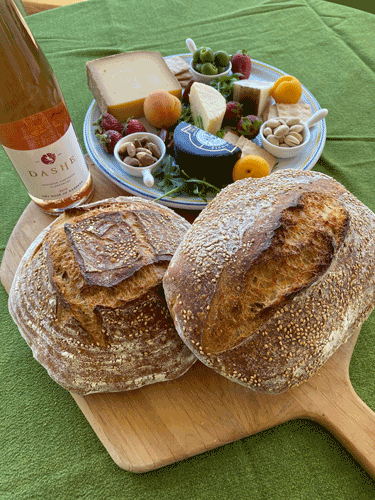
When my kids were unceremoniously kicked out of university and the entire family was bunkered at home, I decided it was time to step up as a fermentation scientist and get to work: fermenting sourdough starter; figuring out the best wines to match with fresh-baked levain bread; and pairing it all with the perfect cheese (a necessity with a French wife and kids).
After all, the best way to keep everyone happy when in close quarters is to keep everyone well-fed and focused on a task that would take everyone’s talents to succeed. My wife is also a winemaker and a hell of a baker, so she would be natural help (although half the time she acted more like a Greek chorus than a French baker). My daughters were brought up as both French and American, so I figured that they would throw themselves into the project simply because they love good food. Not insignificantly, I also figured that baking my own levain bread was going to save me a bundle of money. A good loaf of bread in San Francisco costs a small fortune, so baking my own bread for $0.50 of per loaf was going to be a perfect way to economize while simultaneously creating something we all could enjoy.
The First Step: Natural Yeast or Not?
The winemaking was already taken care of, and the cheese selection would be the last step, so baking the bread was by far the most time-consuming part of the process. It took only a few minutes to decide to make bread with natural yeast starter rather than buying commercial dried active yeast. As someone who has lived in San Francisco since the early ‘80s, I already had an affinity for sourdough bread as a daily staple. Having a warm loaf of sourdough, and then matching it with a freshly steamed-and-cracked crab (with melted butter) and a salad is just about as perfect a meal as there is in my book. There are dozens of great bakeries in the Bay Area that supply bread to the local stores, so our family had already zeroed in on levain—a bread made with wild yeast—as one of our favorite styles of bread.
The first issue was that I hadn’t ever made sourdough bread, much less created a wild sourdough starter. But as a winemaker, I felt that fermentation was going to be the least of my problems, because if anyone could detect a fermentation going wrong, it was going to be me.
Full-disclosure, I cheated at the start, because rather than create my own starter from scratch I decided to get a bit of actively fermenting sourdough starter from friends. It’s a time-honored way to get one’s starter, and it has the advantage that you know from the start what kind of bread the starter can produce. One call to a couple that I knew made great bread, and they were happy to give me a half-cup of starter.
Start with a Good Starter
If there’s anything I learned during this whole process that I could offer as a tip is: get a good, strong, actively fermenting starter. A good starter is the heart and soul of a good levain bread, and it is the one ingredient that requires a bit of work and understanding. For one thing, it is messy. And sticky. And it smells…yeasty. The aroma is not bad at all—in fact, it smells a bit like a very toasty champagne if the champagne was left out overnight—but it is not everyone’s cup of tea. But even if you find the tangy aromas of your starter off-putting, it only requires that you fold it into your dough, because the eventual bread itself has only a slight hint, a whiff, of the tanginess of the starter.
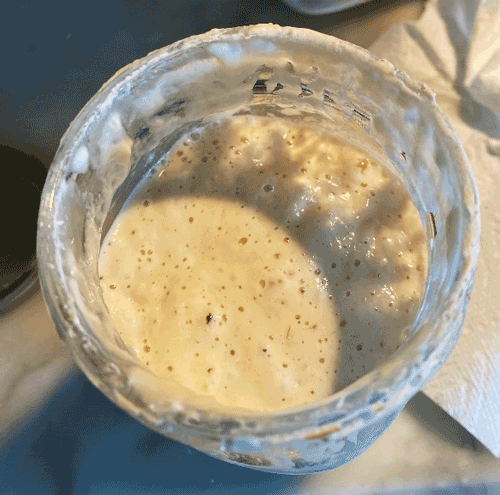
Just a word to the wise: if you need to get a starter and you live in an urban environment, like San Francisco, there are many bakeries out there that will just give you starter if you simply ask them. It is not as if you need a lot of starter, because you only need a half cup or less of starter to commence.
Once you have located a source of starter, the fun has just begun. Once you’ve obtained the starter, you must cultivate it and coax it to be the best starter that it can be. And there is only one way to do that—by feeding it, like it is a living being. Regularly. Every morning and every night. It’s like a pet that doesn’t have the decency to respond to you. Feeding it is not so hard (it is actually just a few spoonfuls of flour and a bit of water), but it’s got to be done regularly if your starter is going to be active and create a semi-decent loaf of bread. You wake up in the morning, say hello to your starter, dump most of it out, and then give the remaining half cup or so some flour and water. By the afternoon, it has doubled or tripled in size (like a man-eating plant in Little Shop of Horrors) and is ready to be used.
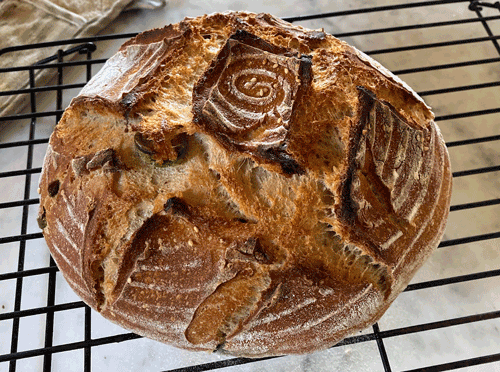
The Zen of Baking: If You Aren’t Patient, You’re Screwed
As a winemaker nothing gets me as worked up as a good fermentation, and although wine still captures the prize for heart-racing full-tank fermentation, a good sourdough starter and bread-making marathon comes in a close second. To start out making bread for the first time, I heartily recommend the YouTube video “15 Mistakes most Beginner Sourdough Bakers Make” from ProHomeCooks—I followed the instructions to the letter and came out with a more than decent result.
I must confess, it takes patience to make levain. Realistically, it’s a day and a half process. I’ve now made bread five or six times, and the only time that the results were less than ideal (i.e. the shape and density of a Frisbee) was when I tried to shorten the process by not giving it the necessary time to rise.
So, take a breath and prepare to make yourself useful while you wait. I won’t go into every step of making the bread (that’s what YouTube videos are for!), but I will let you know a couple of things that I learned in the process.
- First of all, make sure that your starter is as active as possible, and has risen three-fold or more at the time you use it. It should have lots of bubbles on the surface and smell tangy.
- Second, don’t get impatient during the bulk rise step, when you are waiting for your dough to rise before putting it into its final shape. I made the mistake of trying to shorten this step, assuming that the bread would rise as much as it needed during it’s second rise (the “proofing”), but sadly, it didn’t.
- Last, make sure you have a decent Dutch Oven (Le Crueset is the best) to bake your bread. It creates a little steam oven to bake the bread and creates a great crust.
- As extra credit, it helps to get a spiral basket—called a “banneton”—for the final proofing of the dough. It creates the spiral effect that gives the bread a professional look.
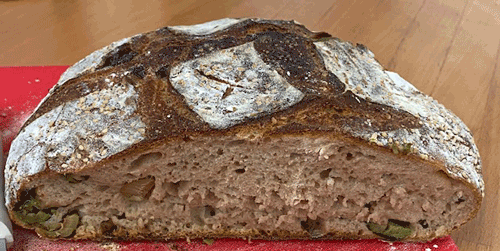
You’ve Baked your Bread, Now Select the Wine
There’s nothing quite as gratifying as slicing into one of your loaves—your creation—and seeing a bread that rivals the best you’ve bought in a bakery. It has a great crust, and the crumb of the bread (the interior structure) is light and airy.
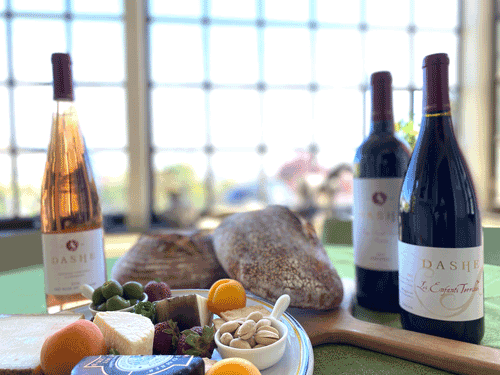
Now, the question is: what wine to pair with the bread? It’s been hot lately, so I’m always partial to rosé this time of year. Personally, I think that rosé goes with almost anything when it’s hot outside, and it goes so well with salad, cheese, and bread that it’s a natural choice.
Click Here for our 2019 Rosé of Barbera, Heringer Vineyard
One of the best aspects of a levain bread is that the subtle nuttiness and tanginess of the bread goes perfectly with a range of wines, especially when you put cheese selections into the mix. In the summertime, I prefer light reds, so Cabernet Franc, Grenache, or Gamays all do well. As a winemaker that specializes in Zinfandels, I would be remiss if I didn’t suggest a lighter Zinfandel style such as our Les Enfants Terribles Mendocino Cuvee, our biodynamic Heart Arrow Ranch Zinfandel, or our Dry Creek Reserve Zinfandel.
Click Here for our 2017 Zinfandel Reserve, Dry Creek Valley
Don’t Forget the Cheese!
My wife and kids provided much of the enthusiasm for creating the bread, trying to keep things into perspective when I was certain that the bread wasn’t rising correctly, etc. They also were the first people in line to slice a piece of warm bread (please, let it rest an hour out of the oven before cutting, so that the texture of the bread isn’t moist and gummy) when the bread comes out of the oven.
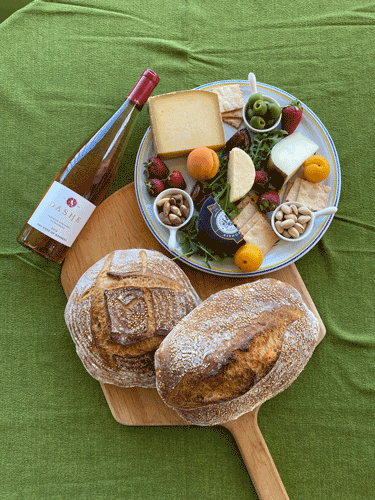
Any French family loves to eat their bread with fresh butter—and definitely salted butter if you’re from Brittany, and salted butter with crystals that crunch if you’re actually IN Brittany). Cut some slices of a nice Comté or Gruyere cheese, or maybe a sheep cheese such as Petite Basque or a Spanish Manchego to go with it, and now you’re talking some serious hedonistic pleasure. We even used a fine English white cheddar and some fruit, to pull everything together.
Combine that with a view of the San Francisco skyline, and the current problems seem much more manageable.
